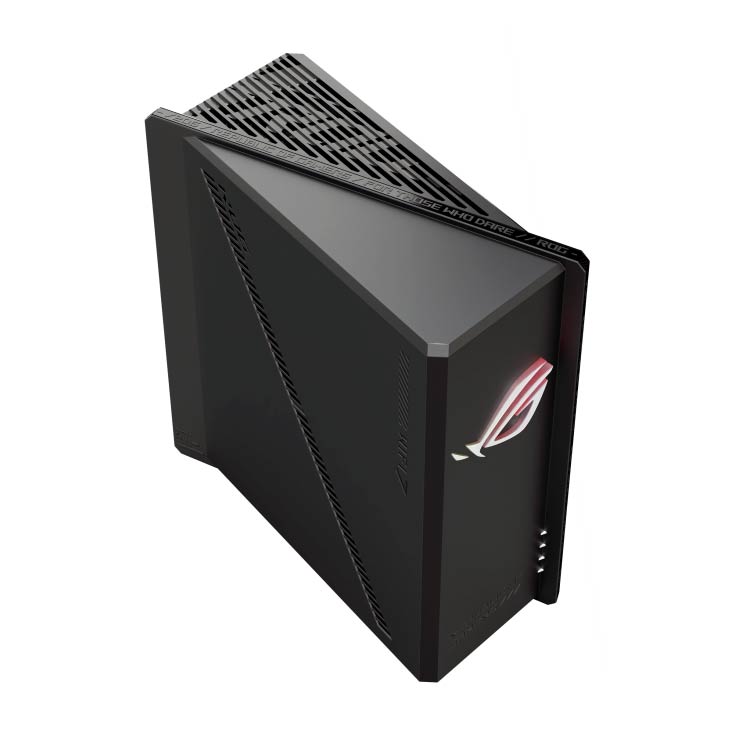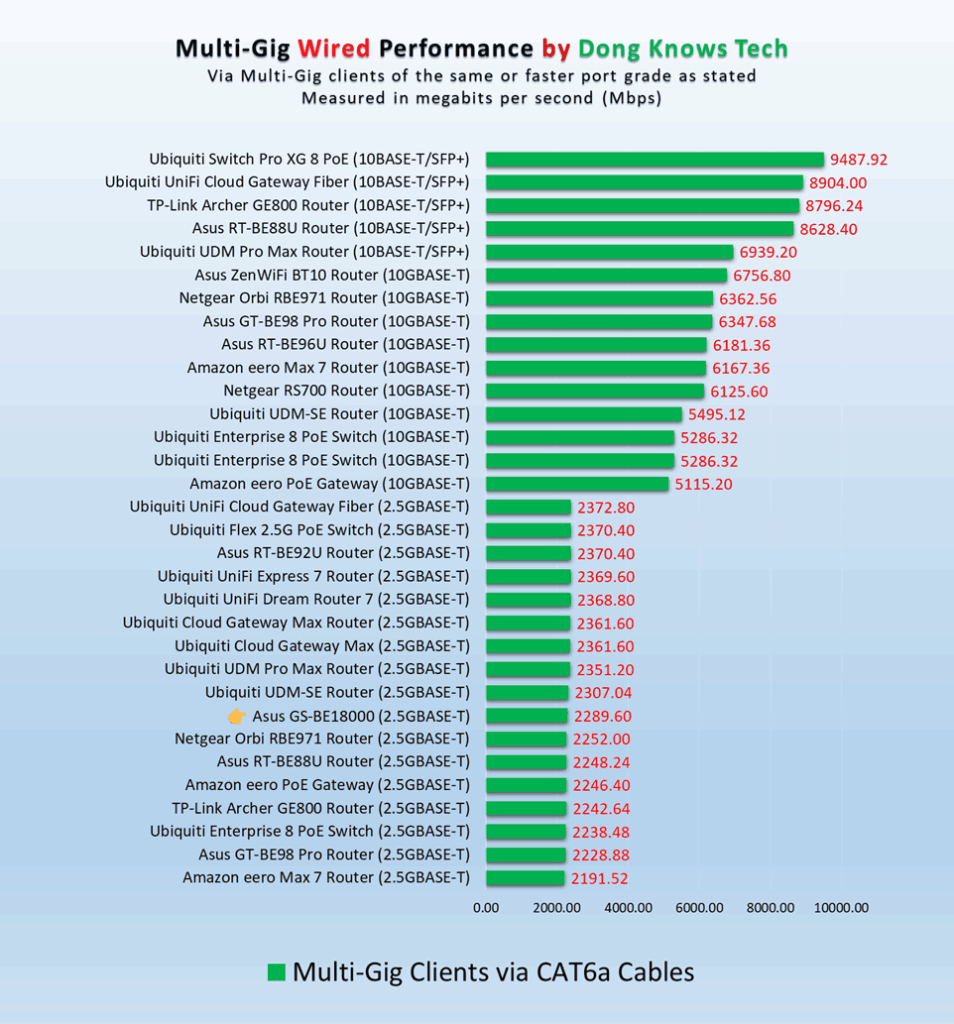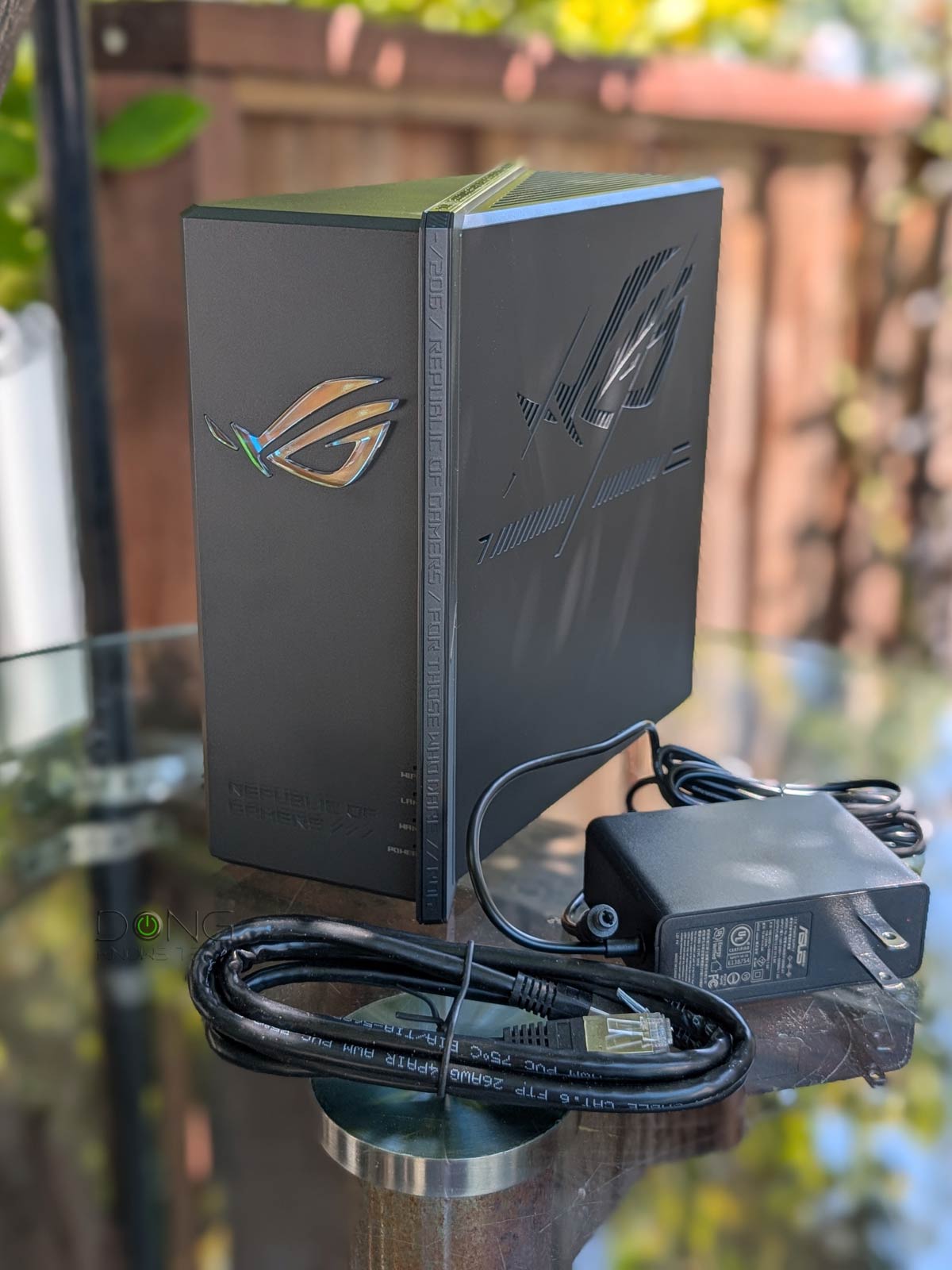The Asus ROG STRIX GS-BE18000 tri-band Wi-Fi 7 gaming router was first available at select retailers on May 20, 2025, together with the TUF-BE9400. However, it wasn’t what it was intended to be at launch due to various reasons.
And I’d say it’s still fully ready today. Still, with the latest firmware release, it has now become a solid performer. Most notably, the firmware also enabled it to be the first home-grade Wi-Fi 7 broadcaster that officially supports the 6GHz band’s sought-after AFC feature.
Here’s the bottom line: If you’re in the market for a gaming router with a ton of 2.5GbE network ports, the GS-BE18000 is worth the current cost of $400, even if you can’t utilize its AFC feature, which proved to be complicated.


Asus ROG STRIX GS-BE18000: A compact top-tier gaming router with entry-level Multi-Gig ports
Out of the box, the GS-BE18000 looks more like a mini computer than a Wi-Fi router. It’s a compact rectangular box designed to stand vertically on a surface—it’s not mount-ready.
On the front, it features a ROG logo with Asus’s ROG Aura RGB lighting effects, which can be programmed via the web user interface or the Asus mobile app.
On the back, there are two vertical rows of eight 2.5 GbE ports, one of which is designated as the default WAN port, with the remaining ports being LANs. Among the LANs, ports 5 and 6 are dedicated gaming ports—connect a device to either, and it’ll automatically be prioritized for games.
On the inside, Asus shares that the GS-BE18000 features two advanced Wi-Fi chipsets: one for the 2.4GHz and 5GHz bands, and the other for the 6GHz band exclusively. These chips feature EMI shielding to work with high-power front-end modules (FEMs) and include eight internal antennas, providing the best possible performance and support for the AFC feature mentioned above.


The router’s high-end Wi-Fi specs make its lack of 10Gbps ports a disappointment. No matter how fast your Wi-Fi is, the router’s bandwidth is limited at its ports, which are all 2.5Gbps. The table below shows its detailed hardware specs.
Asus GS-BE18000: Hardware specifications
| ROG STRIX GS-BE18000 Wi-Fi 7 Gaming Router | |
|---|---|
  |
|
| Model | GS-BE18000 |
| Antennas | 8 x Internal |
| Wi-Fi Bandwidth | Tri-band BE18000 |
| Modulation Scheme (QAM) |
4096-QAM (all bands) |
| 2.4GHz Band (channel width) |
2×2 BE: Up to 688Mbps |
| 5GHz Band (channel width) |
4×4 BE: Up to 5762Mbps (20/40/80/160MHz) |
| 6GHz Band (channel width) |
4×4 BE: up to 11,525Mbps (20/40/80/160/320MHz) (all channels) |
| Multi-Link Operation (MLO) |
Yes |
| Automated Frequency Coordination (AFC) |
Yes (via latest firmware) |
| Network Standards | IEEE 802.11a, IEEE 802.11b, IEEE 802.11g, IEEE 802.11n, IEEE 802.11ac, IEEE 802.11ax, IEEE 802.11be, IPv4, IPv6 |
| Network Features | Web User Interface Asus Mobile App Asus Core Features |
| Gaming Features | Asus Gaming Features |
| Mesh-Ready | Yes (AiMesh) |
| Processing Power | 2GHz CPU, 256MB Flash, 2GB DDR4 RAM |
| Multi-Gig Port | 1x 2.5GBASE-T WAN, 7x 2.5GBASE-T LAN |
| Gigabit Port | None |
| USB Port | 1 x USB 3.0 |
| Hardware Buttons | WPS Button, Reset Button, Power Button |
| Dimensions | 8.86 x 3.54 x 8.86 in (225 x 90 x 225 mm) |
| Weight | 2.04 lbs (927.5 g) |
| Release Date | TBD |
| DC Power Adapter | 100~240 V |
| Firmware Version (for review) |
3.0.0.6.102_38782 |
| Power Consumption (per 24 hours) |
≈ 340Wh |
| US Launch Price | $449.99 |


Asus’s first home (gaming) router with the elusive AFC
As noted in he table above, the GS-BE18000 supports AFC. It’s the first among Asus routers, and among all home routers on the market, in fact, to do so, although it wasn’t the first intended to be. Indeed, initially, Asus wanted the ZenWiFi BQ16 Pro to be the first to feature this capability. Both are AFC-ready in terms of hardware, and neither had the feature at launch.
In late June 2025, Asus released a firmware update (version 3.0.0.6.102_38782) for the GS-BE18000 that turned on AFC. The company informed me that this feature was only available in North America, and its success with the router would determine whether and how soon its other Wi-Fi 7 broadcasters, including the ZenWiFi BQ16 Pro, would also receive it.
Based on my experience with the feature on the GS-BE18000, though, the availability of this feature for indoor broadcasters may not be a sure thing, nor is it significant, at least for the time being, due to the complicated nature of the 6GHz band and the feature itself.
You can dive into the details noted here, but the gist is:
- AFC is available only on the 6GHz frequency band, which itself is regulated differently around the world. Some regions may not have it, while others have only a narrow portion, making it less significant than its potential.
- AFC requires authorization from local regulators. The hardware, therefore, among other things, must know its precise real-world location, which can raise privacy concerns, and the logistics can be complicated.
The point is that even in regions where the AFC is supported, its availability may change over time depending on local regulations and the broadcasters’ availability to determine its precise GPS location. And that proved to be the case of the GS-BE18000 in my experience.
It’s easy to turn on the AFC support on the Asus GS-BE18000. You can do that either via its web user interface or the Asus mobile app. Simply, go to the wireless (or Wi-Fi) section and select to enable the feature.


However, having this feature on doesn’t automatically mean it’s in effect. The router continues to use its default broadcasting mode, called “Low Power Indoor”, until it receives authorization to switch to the higher “Standard Power” mode, which boosts the 6GHz band’s range.
And getting the local authorization is where things became really complicated.
For one, the router itself has no mechanism to determine its precise geographical location, as the information it can obtain from the WAN IP address is not accurate enough. Instead, it draws the location from connected clients, such as smartphones. This is generally the case with all home-grade routers that support AFC.
Specifically, Asus told me that I should use the Asus router app on my phone, which is a Pixel 9 Pro XL, and:
- Enable the AFC feature, or make changes to it, such as changing the 6GHz band’s channel width, through the app while your phone is connected to the router’s Wi-Fi.
- Doing that while the phone is being used in the open to get the best GPS signal.
While it sounds simple enough, keep in mind that when you turn the AFC feature on or off, it will cause the 6GHz band, if not the router itself, to restart, which in turn will cause the phone to disconnect from the router. Now, you’ll need to reconnect when the 6GHz SSID becomes available again to check if AFC is in effect.
Alas! In my trial, GS-BE18000’s AFC was never in effect because it never found my phone’s GPS geolocation uncertainty within the accepted level to switch to the “Standard Power” mode. During my entire weeks-long trial, the router remained in “Low Power Indoor” mode, despite having AFC turned on.
Possibly, at some point, this might have been in effect, but if so, I wasn’t aware of that. The point is that, for now, in most cases, you should expect to use this router as a non-AFC broadcaster, just like with all other home Wi-Fi routers. Asus told me that it “continues improving the detection logic” for future firmware releases.
With AFC, or the lack thereof, out of the way, let’s proceed with the GS-BE18000 as it is at its core: another familiar gaming router.
A typical tier-1 gaming router
As part of the ROG STRIX family, the GS-BE18000 has the standard set of Asus’s gaming features, plus Game port and the ROG Aura RGB lighting effects. Unlike higher-tier 2 gaming hardware, it doesn’t support a gaming private network or Game Radar. Still, it has everything most gamers need. The table below shows how it compares to other gaming routers from Asus.
All of these routers have the standard set of Asus’s gaming features, including Mobile Game Mode, Open NAT, Gear Accelerator, and VPN Fusion.
Other than that, running ASUSWRT 5.0, the router has the core features of all Asus routers with slight differences in various areas. Specifically, you can expect the following:
- Flexible WAN/LAN configurations:
- The GS-BE18000 features dual-WAN. You can use its default WAN and turn one of its LAN ports or the USB port into a second WAN port.
- Use the USB port as a third WAN source to host a tethered smartphone or cellular modem.
- Unlike most other Asus routers, the GS-BE18000 does not feature Link Aggregation. That’s likely because there’s little practical use in bonding two 2.5Gbps ports into a 5Gbps link.
- Universal backup restoration: The GS-BE18000 can load the backup file of almost any other Asus router, making upgrading from one router to another quick and easy. I tried using the backup files of the RT-BE86U and a few others, and they loaded without any issues. (Note, though, that not all settings can be ported, depending on the models, and generally, it’s best to set up a router from scratch.)
- Robust web user interface with optional Asus Router mobile app. You can set up the router the way you do any standard router via its default IP address, which is 192.168.50.1.
- AiMesh support. The GS-BE18000 works best with wired backhauling, but thanks to MLO, it can be reasonably used with any other tri-band Wi-Fi 7 AiMesh broadcaster in a wireless setup, as long as multiple units are used (and not a mixed hardware setup).
- Built-in Parental Controls and online protection (AiProtection) plus other traffic-related features.
- USB-based features (cellular tethering, network storage, media streaming server, etc.)
- The new router supports advanced VPN, including WireGuard and Instant Guard.
- Tons of helpful network/Wi-Fi settings, tools, and other features, including QoS and web-based remote management via Dynamic DNS.
So, if you had an Asus router before moving to the GS-BE18000, it would be a walk in the park. Most of what it can do is self-explanatory.


Asus ROG STRIX GS-BE18000: Solid performance even without AFC
I tested the GS-BE18000 for a few weeks, during which a significant amount of time was spent on the AFC feature, which was never in effect—I’m from the San Francisco Bay Area. The way this feature works, your luck with this router will always vary, especially when used indoors.
Other than that, with the latest firmware, the GS-BE18000 performed well with Wi-Fi rates being limited only by its network ports, as shown in the charts below.


The router’s range proved to be similar to that of a high-end Wi-Fi 7 router. It’s challenging to measure coverage precisely, but if you live in a home of around 2,500 ft² (232 m²) with thin walls, placing this router near the center should likely provide blanket coverage. Still, your mileage will vary.
I tested the GS-BE18000’s NAS feature by connecting a portable SSD to its USB 3.0 port, and the performance was relatively modest. Via a 2.5Gbps wired connection, the data transfer rates sustained between 50MB/s and 75MB/s for write and read operations, respectively. That’s fast enough for casual data sharing, but not much else.


The router’s 2.5Gbps ports themselves performed as expected, averaging middle of the pack when compared with other routers of the same port grade.
The GS-BE18000 seemed to have no internal fan, and it was silent during operation. It also remained cool to the touch, which is always a good thing. With the latest firmware, it also passed my three-day stress test without disconnecting once, demonstrating its reliability as a Wi-Fi machine. It’s essential to note that I performed the street test without any of its gaming or traffic-related features enabled.


Overall, except for the elusive AFC feature, the GS-BE18000 proved to be a good router from a performance perspective.
Pros
Excellent overall performance; eight 2.5Gbps ports; AiMesh-ready
Lots of free, in-depth, and useful networking features and settings (VPN, AiProtection, Parental Control, Bandwidth monitoring, etc.)
No vendor required login account; fanless; runs cool and quiet
Cons
AFC is generally not available (yet) due to lack of GPS
NAS performance (when hosting a portable SSD) could be better
Conclusion
In a way, the Asus ROG STRIX GS-BE18000 offers the reason why the adoption of Wi-Fi 7’s AFC has been slow. It’s a complicated feature. Hopefully, with time, things will get better.
Until then, this gaming router is a solid performer for those who need no more than 2.5 Gbps of bandwidth. Having a Gig+ broadband connection? Consider it today!
